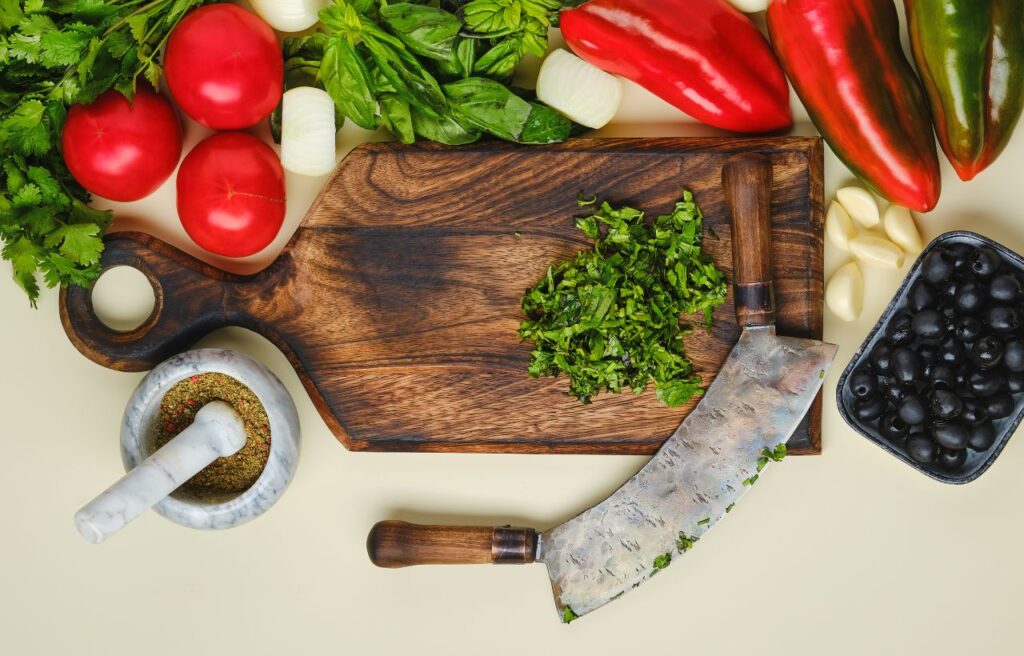The mezzaluna knife, a uniquely designed culinary tool, has a rich history and an enduring presence in kitchens around the world. In this article, we’ll explore the origins of the mezzaluna knife, its evolution over time, and its continued relevance in modern cooking.
Table of Contents
A Glimpse into the Past: Origins of the Mezzaluna Knife
The mezzaluna knife, which translates to “half-moon” in Italian, gets its name from the curved, crescent-shaped blade that characterizes its design. Though its exact origins are difficult to pinpoint, it is widely believed that the mezzaluna knife emerged in Italy during the 18th or 19th century. This innovative tool was developed to meet the needs of Italian cooks, who required a versatile and efficient instrument for chopping and mincing ingredients in their bustling kitchens.
The Evolution of the Mezzaluna Knife
Over the years, the mezzaluna knife has undergone several changes in design and materials. Early mezzaluna knives were typically made from iron or steel, with a single wooden handle affixed to the blade. As the tool evolved, a second handle was added, enabling users to grip both ends of the blade and apply equal pressure for more precise and efficient cutting.
In addition to changes in design, modern mezzaluna knives are now made with a variety of materials. Blades may be crafted from stainless steel, carbon steel, or even high-quality alloys, while handles are often made from wood, plastic, or other durable materials. The variety of materials and designs available today ensures that cooks can find a mezzaluna knife that suits their preferences and needs.
The Many Applications of the Mezzaluna Knife
The Mezzaluna knife is renowned for its versatility and is used for a wide range of culinary tasks. Some of the most common applications include:
- Chopping herbs and spices: The curved blade allows for a rocking motion, making it easy to finely chop herbs and spices without bruising them.
- Mincing garlic and onions: The Mezzaluna knife’s sharp blade effortlessly minces garlic and onions without releasing their pungent juices, which can cause tearing.
- Slicing pizza and flatbreads: With a swift rocking motion, the Mezzaluna knife can cut through pizza and flatbreads without disturbing the toppings or creating uneven slices.
- Chopping nuts and chocolate: The Mezzaluna knife’s broad blade makes it easy to chop nuts and chocolate into uniform pieces.
- Making salads and salsas: The Mezzaluna knife can efficiently chop various ingredients for salads and salsas, ensuring even distribution of flavors.

The Enduring Appeal of the Mezzaluna Knife
Despite the abundance of kitchen gadgets available today, the mezzaluna knife remains a popular choice among both professional chefs and home cooks. Its enduring appeal can be attributed to several factors:
- Efficiency: The curved blade of the mezzaluna knife allows for a rocking motion, which enables users to chop and mince ingredients quickly and efficiently. This is particularly useful for tasks such as chopping herbs, mincing garlic, or dicing vegetables.
- Versatility: In addition to chopping and mincing, the mezzaluna knife can be used for a variety of other tasks, including slicing pizza, cutting through pastry dough, or even chopping nuts and chocolate.
- Ease of Use: The dual handles of the mezzaluna knife offer greater control and stability, making it easy for users of all skill levels to achieve consistent, precise cuts.
- Safety: The design of the mezzaluna knife reduces the risk of injury, as the fingers are kept away from the blade while the dual handles provide a secure grip.
💡 How To Peak The Best Knife For Cutting Vegetables?
Choosing the Right Mezzaluna Knife for Your Needs
When selecting a Mezzaluna knife, it is essential to consider the following factors:
- Size: Choose a size that suits your needs, from compact models for small tasks to larger versions for heavy-duty chopping.
- Blade material: Opt for a stainless steel blade for durability and easy maintenance.
- Handle design: Select a Mezzaluna knife with ergonomic handles to ensure a comfortable grip and prevent hand fatigue during prolonged use.
- Safety features: Look for Mezzaluna knives with blade guards or sheaths to protect the blade and your fingers when not in use.
In conclusion, the mezzaluna knife boasts a rich history and has evolved over time to meet the changing needs of cooks. With its unique design, efficiency, versatility, and ease of use, it’s no surprise that this Italian chopper remains a beloved tool in kitchens worldwide.






